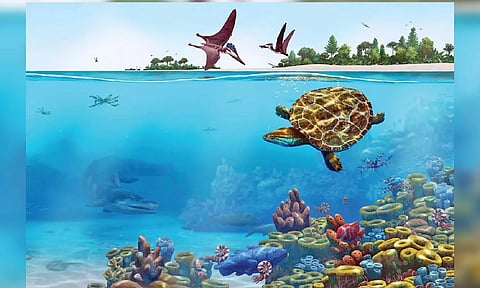

Today it is Bavaria, a region of Germany. But in the Late Jurassic Period, it was a shallow tropical archipelago ringed with sponge reefs. The hyper-saline, oxygen-poor conditions of these waters prevented scavengers from disturbing the bodies of animals that died in the lagoons.
Some 150 million years later, that has been very good news for paleontologists, who for more than 100 years have pulled complete fossils of everything from fish to marine reptiles, pterosaurs and feathered dinosaurs like Archaeopteryx from the Solnhofen Limestone.
The area’s latest find is a beautifully preserved — if pancaked — turtle. Described in an article published Wednesday in the journal PLOS One, the specimen represents an approach to marine life unlike that of any shelled reptile today.
The turtle’s name is Solnhofia, said Felix Augustin, a paleontologist at the University of Tübingen in Germany and an author of the study. Originally named in 1975, for decades the creature was known only from a pair of skulls found in Bavaria and Switzerland. A few more scrappy remains turned up in 2000.
The new specimen — which was recovered by a private collector from a quarry near the German city of Painten — is the entire nine-inch animal. “It’s the most complete and best preserved one so far,” said Marton Rabi, a paleontologist also at the University of Tübingen and another author of the study.
This preservation is a blessing and a curse. “Anatomists most like disarticulated skeletons where we can turn around the bones and really study details of anatomy,” Dr. Rabi said. “That’s not really possible with these articulated skeletons, and they’re not easy to CT scan either — they’re pretty flat and large.”
Solnhofen has preserved other examples of the first sea turtles, which evolved from a terrestrial lineage before adapting to freshwater and then to shallow marine environments like those found in Jurassic Bavaria.
“In this southern German region, the diversity of sea turtles is surprisingly high,” Dr. Rabi said. “There are way more species than there are today, and many of them haven’t yet been described.” These turtles differed significantly from their distant modern relatives, Dr. Rabi added. Solnhofia’s lineage was part of a family of side-necked turtles, a group that tucks their heads alongside their shells rather than fully withdrawing them. The animals also lacked the stiffened, specialised paddles that would appear on open-water turtles in the Cretaceous Period, and may have also lacked specialised salt-removal glands found in modern sea turtles.
“Modern sea turtles have near global distribution and do these insanely long migrations. They’re highly adapted to a marine lifestyle,” Dr. Rabi said. “These marine Jurassic sea turtles were not capable of that.”
Nonetheless, coastal, clawed marine turtles were incredibly successful throughout the remainder of the Mesozoic Era, evolving numerous times in several animal families. While Solnhofia went extinct at the end of the Jurassic as sea levels fell and the European archipelagos briefly dried out, the family lingered through the extinction of the dinosaurs, evolving bizarre representatives with cue-ball shaped heads in the Eocene Epoch before finally disappearing.